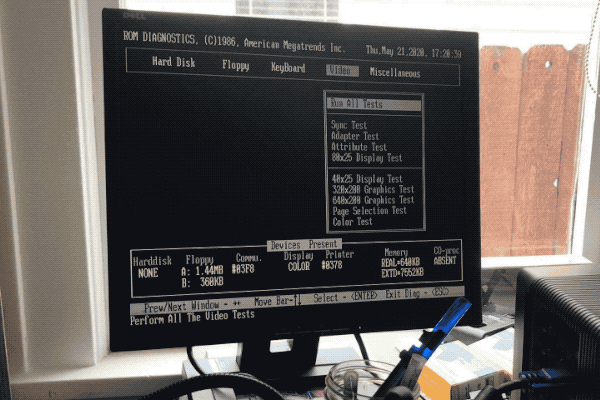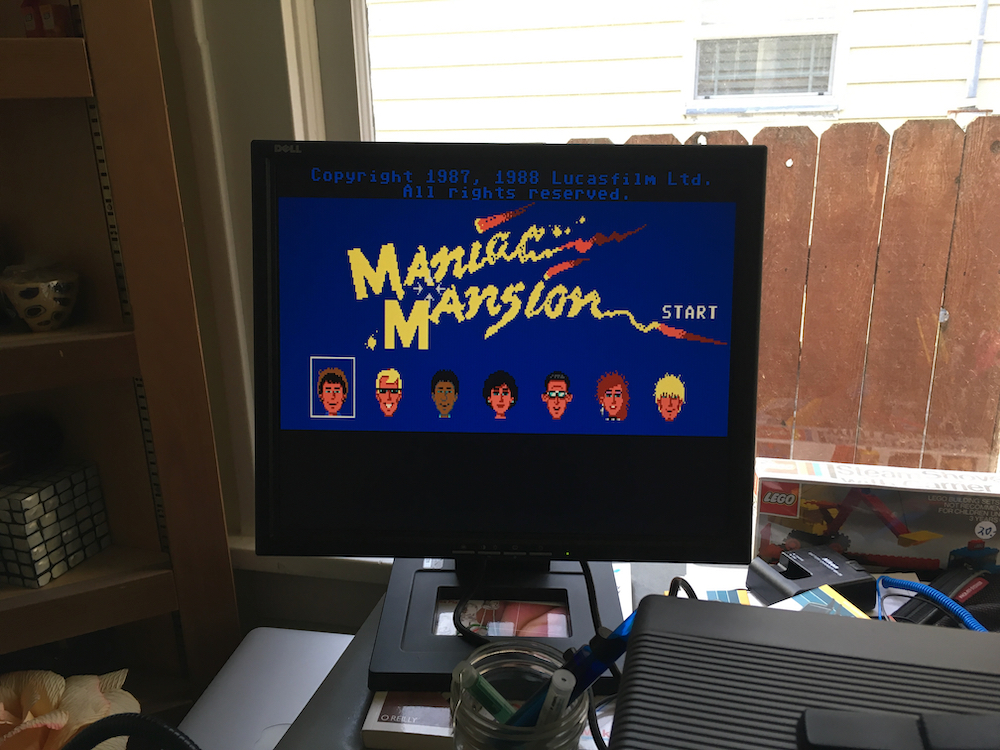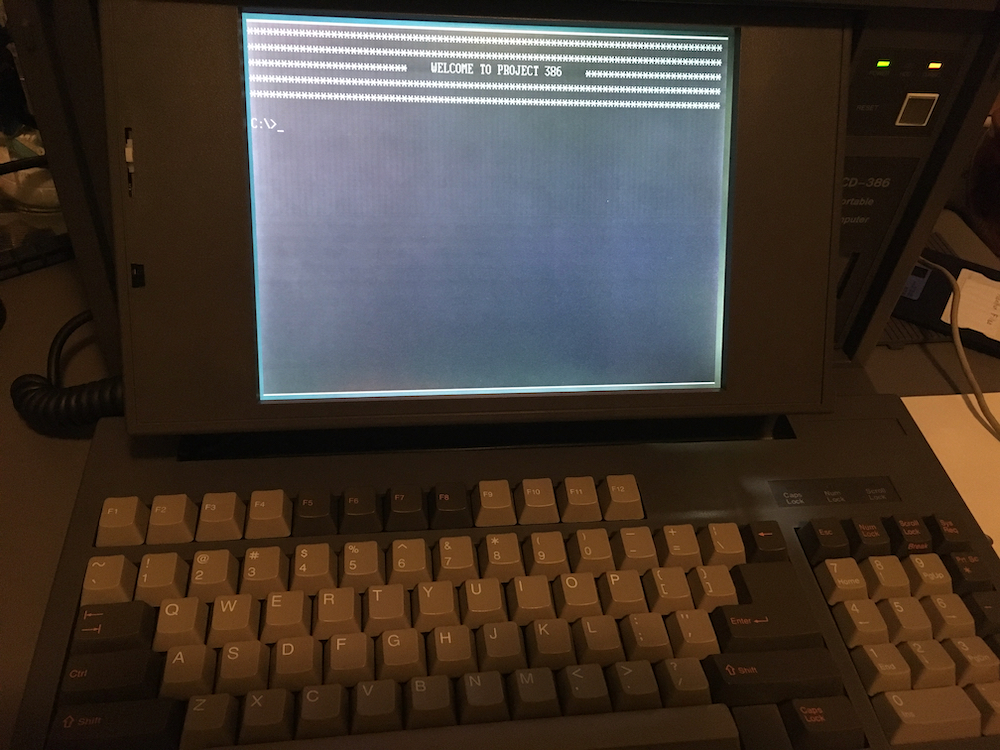Project 386 #4: Against all odds, success
This is post is long overdue, since as I leaked a few weeks ago, I got the dang computer to work! I’m still completely amazed. I’m not totally out of the woods, as any other part of this could die on me at any moment, but things seem pretty solid for now. I wanted to write a bit about the technical side, but also to write more about what I’ve learned by going back in time.
The root technical problem
The basic gist came down to the old, leaking, corroded battery I mentioned in my second post ruining a few traces on the motherboard, and me painstakingly testing them and then attempting two repairs with small wires and some soldering.


I tried to keep a steady hand and did the most delicate soldering of my life. Incredibly, the computer booted the first time! All of the red herrings, from the power supply to the memory chips (all forty components of the 8MB work just fine!) to the video card proved to be non-issues once the computer itself was able to boot again, maybe for the first time in decades.

Unfortunately, the hard drive seemed to be toast, so I couldn’t boot an actual operating system or get at any files (other than those on the included floppy disks), but I had a vintage-era spare to replace it with and I was off to the races.

All systems go
Once those minor details (!) were out of the way, it’s been non-stop fun, exploration, spelunking, and a bit of reflection since then. The number of things that I’ve moved through in the past few weeks has been kind of head-spinning. I’ve been wanting to take the time to blog all along, but… well, there’s a lot going on these days.
Recently, I’ve been exploring:
- Installing MS-DOS 6.22 and making good use of my
CAPS LOCKkey - Installing Windows 3.1, then Windows for Workgroups 3.11 (which I never got to use on my own computers, only on demo PCs at the mall)
- Installing a sound card from my other old PC
- Getting DOS networking going and using the excellent mTCP for FTP and SSH, which was a welcome addition over sneakernet and lots of floppy disk reuse, 1.44MB at a time
- Revisiting BASIC programming, but this time in QBasic instead of booting directly into interpreters from ROM like I did as a kid
- Starting to learn Pascal (a programming language created in 1968) and making my own
.EXEprograms - Continuing to experiment, without success, in installing Linux and FreeBSD operating systems (though I did get the excellent but defunct single-floppy HAL91 working, albeit without networking support)
- Figuring out how to swap between the internal, monochrome LCD panel and a color external monitor using utilities on the floppies that came with the thing (which I’d love to reverse engineer for Linux or other systems)
- Installing After Dark for DOS (flying toasters!)
- Tuning batch scripts and custom boot settings
- And of course, playing some old DOS games like the King’s Quest series, Maniac Mansion, Oregon Trail, Zork, Wolfenstein 3D, and others
I mean, there’s been so much. One of my favorite activities has been browsing resources like My Abandonware and Internet Archive’s vintage software collection and looking for programs and box art that I recognize from stores and catalogs in my youth and then finally getting to see what those things were like—for free! Thirty years of waiting is a small price to pay.


The bigger picture
The most interesting thing about all of this, however, has been the feeling of immersing myself in technology from thirty years ago. There are a couple broad takeaways that have been giving me a lot to think about.
Focus
DOS is single-user, single-tasking operating system. When you sit down at the computer, you are in complete control of everything that happens and, more or less, any program can affect any other thing on the system. It’s hard to convey what this is like to people only familiar with modern computers. There is no clock up in the corner, or music playing, or social media or email piling up in the background, or indicators, or push notifications. What you are sitting down to do, at the computer at that moment, is everything the computer is doing. The resources are slim by today’s standards, but the focus is extreme.


Yes, there are ways to put some things into the background for easy access (I learned all about DOS’s system of terminate-and-stay-resident) but resources are precious. On this system, background utilities include a mouse driver in case I need to use the mouse for a game or utility, some sound card settings, some shortcut commands for less typing, a screensaver, and not much else.
When you’re online, you’re not just online. You are “online-capable”, and then you launch a program which uses the network connection, in the foreground, until you are done, then you quit the program and you are no longer online until you repeat the process.
The result, probably unsurprisingly, has been an amazing mental focus. It is reminding me of the days when you chose to use a computer for a particular task, rather than to have it be the default behavior to carry you through work, todo lists, and boredom. This post by Charlie Harrington about his “new old Apple IIe” (which I linked to a month back) sums it up well:
This computer represents to me the lost era of computer as appliance. I’m talking about “bicycle for the mind” type-of-stuff. When you still sat down and said, “I’m going to computer now.” Or, as in my childhood, “May I please go on the computer now, Mom, PLEASE?”
We’re much closer to cyborgs now, with our phones and watches and speakers and other do-dads. Computers are part of us. They’re attached to us, they’re in our pockets, they’re in our bags, they’re next to us when we go to sleep. You can’t escape them, and as a result, you’re no longer able to make an active choice about whether or not to use them.
I love this conscious choice to “go computer” now. It’s very refreshing.
A new hobby
I guess I shouldn’t really be surprised, but the long quest of reviving this thing has led me to a deep appreciation for this era of computing. I guess I originally thought this computer was sort of an isolated gadget in time that I would gut and do fun public art things with. The deeper I got, the more I realized how it connected me to the time period when people actually chose to bring computers into their homes and lives and, for the most part, before anyone, and certainly I, was on the internet. The computer feels more like a shop tool or kitchen appliance than your connection to billions of people, infinite knowledge, mountains of data, and endless news, updates, and opinions.
After spending weeks reading niche online forums (shout out to VOGONS), doing all sorts of research, and breathing life into things, I realized that it’s basically a two-orders-of-magnitude-cheaper-but-just-as-oddball version of my 1985 VW van. Diehard enthusiasts, on the periphery of the internet, keeping old technology alive and finding elegance and novelty in the designs of long-forgotten engineers and makers.

I’m even, perhaps crazily, thinking about another side business making peripherals and upgrades for enthusiasts. In this and a lot of other electronics-related maker things, I’ve been really inspired by folks on Tindie. This is a bit beyond my current skill level, but I am finding stuff like this custom sound card super cool. We’ll see what happens with that.
Next up
Since this is a particularly weird computer, with the all-in-one case design, and it was a real bear to find lots of details on some of its more esoteric things like the video card, I’m hoping to document what I’ve found and figured out and get its print materials online. I’m now at 219 web bookmarks for this project.
As I mentioned above, I’m learning Pascal (via Borland Turbo Pascal 7.01 from 1992), which actually hasn’t been super painful. It’s been interesting, too, to puzzle through things more rather than just find dozens of people talking about a problem on Stack Overflow. I’ve got PDF versions of large manuals, the computer, and my brain to do some trial and error in a lot of cases. I think assembly language might be in the cards for me, too, which is a new area.
I’m going to start getting more familiar with hacking and bending the hardware to my will, to learn a bit more about how this era of computer worked, how some of the fun hacks were done, and what we can do today with knowledge of modern technology looking back.
I think it’d also be fun to do some video podcast thingies going over various interesting uses, quirks, and features of the computer. Would anyone be interested in that?
Stay tuned for more. Even if this thing dies again, I’ll be still be here, pulling it along further into the 21st Century.